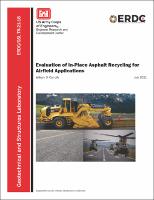Please use this identifier to cite or link to this item:
https://hdl.handle.net/11681/41142Full metadata record
| DC Field | Value | Language |
|---|---|---|
| dc.contributor.author | Carruth, William D. | - |
| dc.date.accessioned | 2021-07-13T18:02:04Z | - |
| dc.date.available | 2021-07-13T18:02:04Z | - |
| dc.date.issued | 2021-07 | - |
| dc.identifier.govdoc | ERDC/GSL TR-21-18 | - |
| dc.identifier.uri | https://hdl.handle.net/11681/41142 | - |
| dc.identifier.uri | http://dx.doi.org/10.21079/11681/41142 | - |
| dc.description | Technical Report | en_US |
| dc.description.abstract | Over the last few decades, in-place recycling of asphalt pavements has seen increased use by the highway industry, primarily to take a dvantage of potential cost and logistical savings compared to conventional reconstruction. More recently, the U.S. Navy and Federal Aviation Administration have allowed recycling to be used on airfields with lighter traffic. This report contains a discussion of in-place recycling design considerations obtained from a literature review of its use in the highway industry. Observations developed from a review of airfield pavement projects that have utilized recycling is also included. A structural analysis was performed using the Pavement-Transportation Computer Assisted Structural Engineering (PCASE) tool to determine typical stiffness values that recycled layers must achieve to support various types of military aircraft traffic for different pavement structures. Overall, in-place recycling is recommended for consideration as a rehabilitati on technique for military airfield pavements, and further investigation is recommended before it is implemented it into design guidance. | en_US |
| dc.description.sponsorship | Prepared for U.S. Army Installation Management Command under MIPR 11141371000001 | en_US |
| dc.description.tableofcontents | Abstract ................................................................................................. ii Figures and Tables ............................................................................ v Preface ........................................................ vi 1 Introduction .............................................................................. 1 1.1 Background .............................................................................. 1 1.2 Objective and scope ...................................................................... 2 1.3 Outline of chapters ......................................................................... 2 2 Overview and Design Considerations ............................................. 3 2.1 Overview ................................................................................... 3 2.2 Types of stabilizers ......................................................................... 3 2.3 Design moisture content ....................................................... 4 2.4 Determination of binder content .................................................... 5 2.4.1 Single component binder systems ............................................. 5 2.4.2 Multiple component binder systems .......................................... 7 2.5 Construction procedures .......................................................... 8 3 Case Studies of In-Place Recycling for Airfield Applications .......... 10 3.1 Mayport NS ................................................................................. 10 3.1.1 General layout and construction history .................................. 10 3.1.2 Findings from condition surveys 2001 - 2014 ........................... 12 3.1.3 2016 rehabilitation using full-d epth reclamation .................... 13 3.1.4 Findings from 2017 evaluation report ...................................... 15 3.1.5 Overall discussion of NS Mayport project ................................. 16 3.2 Whiting NAS ............................................................................ 16 3.3 Discussion of FAA P-207 specification ................................. 18 4 Structural Analysis ........................................................................ 20 4.1 Traffic groups considered .......................................................... 20 4.2 Design assumptions ................................................................... 21 4.3 Results and discussion ........................................................... 22 5 Conclusions and Recommendations ............................................ 28 5.1 Conclusions ......................................................................... 28 5.2 Recommendations .................................................................... 29 References ..................................................................................... 30 Appendix A: Structural Analysis Raw Data ........................................ 33 Acronyms and Abbreviations .........................................................Unit Conversion Factors ........................................................................ 44 Report Documentation Page.. 43 | - |
| dc.format.medium | - | |
| dc.format.medium | 54 pages / 11.26 MB | - |
| dc.language.iso | en_US | en_US |
| dc.publisher | Geotechnical and Structures Laboratory (U.S.) | en_US |
| dc.publisher | Engineer Research and Development Center (U.S.) | - |
| dc.relation.ispartofseries | Technical Report (Engineer Research and Development Center (U.S.));no.ERDC/GSL TR-21-18 | - |
| dc.rights | Approved for Public Release; Distribution is Unlimited | - |
| dc.source | This Digital Resource was created in Microsoft Word and Adobe Acrobat | - |
| dc.subject | In-place recycling | en_US |
| dc.subject | Full-depth reclamation | en_US |
| dc.subject | Pavements, Asphalt – Recycling | en_US |
| dc.subject | Cold in-place recycling | en_US |
| dc.subject | Airfield Pavement rehabilitation | en_US |
| dc.subject | P-CASE | en_US |
| dc.subject | Asphalt pavements | en_US |
| dc.subject | Structural design | en_US |
| dc.subject | Pavements – Evaluation | en_US |
| dc.subject | Runways (Aeronautics) | en_US |
| dc.subject | Structural engineering – Computer programs | en_US |
| dc.title | Evaluation of In-Place Asphalt Recycling for Airfield Applications | en_US |
| dc.type | Report | - |
| Appears in Collections: | Technical Report | |
Files in This Item:
| File | Description | Size | Format | |
|---|---|---|---|---|
| ERDC-GSL TR-21-18.pdf | 11.26 MB | Adobe PDF |  View/Open |